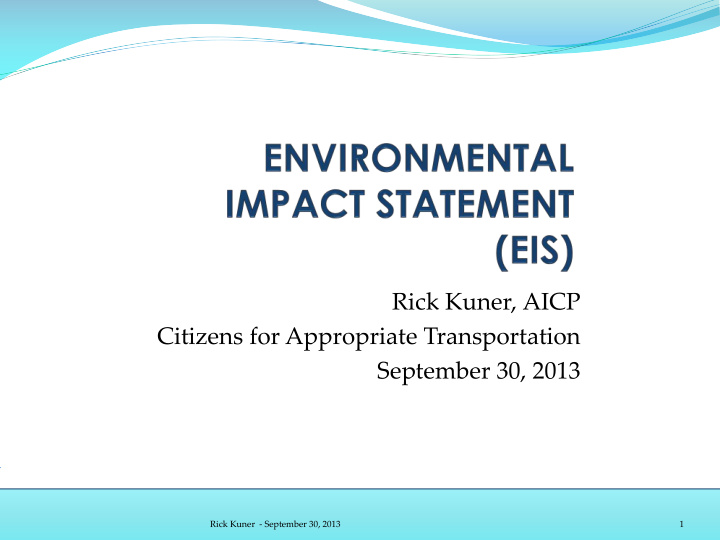



Rick Kuner, AICP Citizens for Appropriate Transportation September 30, 2013 Rick Kuner - September 30, 2013 1
An Environmental Impact Statement (EIS) does two things: 1. Recommends a Preferred Alternative 2. Identifies Mitigation Measures to limit negative environmental impacts. NEPA Policy is Avoid – Minimize – Mitigate Avoid negative impacts. 1. Minimize negative impacts if you cannot avoid them. 2. Mitigate negative impacts if you cannot avoid or 3. minimize them. Rick Kuner - September 30, 2013 2
1 . Purpose and Need 1. Document the need for the project 2. Explain the purposes of the project Rick Kuner - September 30, 2013 3
2. Prudent & Feasible Alternatives Build Alternatives do little to reduce congestion in the General Purpose Lanes Design Ramps no higher than grade level Use some of the CSX track space CTA Blue Line can transport more persons than expressway lanes Transportation and Land Use should work together Consider all Crash Mitigation Factors Rick Kuner - September 30, 2013 4
Daily Hours of Congestion (Weekday) for General Purpose Lanes 20 18 16.75 16.5 16.5 16.25 15 Hours 10 5 0 2040 No GP & EXP HOV 2+ & HOT 3+ & TOLL & Build + EXP & HCT HCT HCT HCT 2040 No Build and Round 3 Build Alternatives Rick Kuner - September 30, 2013 5
CSX Right-of-Way Rick Kuner - September 30, 2013 6
Crash Mitigation Factors 1. High Traffic Volumes decrease space between vehicles, so crash frequency is higher 2. Lane Widths are usually 12 feet, but IDOT is proposing 11 foot lanes at the Oak Park Avenue Pinch Point 3. Shoulder Widths 4. Speed Differential among Lanes 5. Extent of Recurring Congestion Rick Kuner - September 30, 2013 7
3. Rigorous Analysis of Impacts a. Air Quality b. Noise c. Social / Economic d. Environmental Justice e. Parks – Barrie, Rehm, Conservatory, Wenonah f. Historic / Architectural – Gunderson District g. Energy h. Property Acquisition i. Construction Mitigation Rick Kuner - September 30, 2013 8
4. Comprehensive & Fair Evaluation of Alternatives Economic development, environmental, financial, and social criteria are not considered yet. IDOT rejected alternatives in Round 2 prior to considering these criteria. NEPA sets minimums. There is no reason IDOT cannot do more. Small differences among performance scores projected to Year 2040. Rick Kuner - September 30, 2013 9
5. Meaningful Citizen Participation 1. 10 months to respond to June 2012 IDOT requested 2. Three “Connections” News since October 2009 (four years into IDOT’s Study) 3. Flawed planning process Rick Kuner - September 30, 2013 10
How an EIS Process Ends 1. Draft Environmental Impact Statement (DEIS) 2. Public Comment Period 3. Final Environmental Impact Statement (FEIS) 4. Record of Decision (ROD) Issued by the U.S. Federal Highway Administration (FHWA) Rick Kuner - September 30, 2013 11
Concluding Comments 1. We are not seeing the best alternatives from IDOT. 2. If we do nothing, we will get a poor solution . 3. The decisions we make will have long-term, significant impacts. Rick Kuner - September 30, 2013 12
Rick Kuner - September 30, 2013 13
Recommend
More recommend